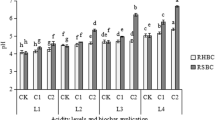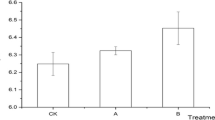Abstract
Purpose
Biochar has become a research hotspot in soil heavy metal pollution remediation. However, there are few studies on the effect of biochar on the heavy metal accumulation in rice under different irrigation regimes, and there is very limited information on the soil heavy metal speciation changes during whole rice growth period. This study aims to clarify the effect and mechanism of biochar on Cd and Cu accumulation in rice grains under different irrigation regimes.
Materials and methods
The rice straw biochar (0 g kg−1 (CK), 20 g kg−1 (BC20), 40 g kg−1 (BC40), and 60 g kg−1 (BC60)) was applied to the paddy soil (contaminated with Cd and Cu) under three irrigation regimes (flooding irrigation (FI), intermittent irrigation (II), and wet irrigation (WI)), and a rice pot experiment was carried out for two consecutive years. The speciation changes of Cd and Cu in the soil during the key stage of rice growth and the metal content of each part of the rice were analyzed.
Results and discussion
Biochar promoted the formation of reducible and oxidizable Cd throughout the rice growth period, while the acid-extractable and residual forms were dynamic and affected by irrigation regimes. A significant reduction in acid-extractable Cu content was observed, and biochar mainly converted the acid-extractable Cu to oxidizable Cu, while reducible Cu was sensitive to soil water conditions. As biochar reduced soil available Cd content, BC60 decreased Cd content in brown rice by 50.41%, 70.32%, and 81.52% under FI, II, and WI, respectively, but the Cd content in brown rice was the lowest in FI. Biochar decreased the Cu content in brown rice under FI (maximum 31.2%), while significantly increased Cu content under II (maximum 74.33%) and WI (maximum 49.3%) because biochar increased soil available Cu content after rice heading stage and encouraged its transport from root to shoot.
Conclusions
Rice straw biochar can be used to control Cd pollution in rice under various irrigation regimes, and the effect is better when combined with flooding irrigation. The application of rice straw biochar to control crop Cu pollution is not suitable for water-saving irrigation.



Similar content being viewed by others
References
Ao M, Chai G, Fan C, Liu G, Qin S, Wang P (2019) Evaluation of potential pollution risk and source analysis of heavy metals in paddy soil and rice. T Chinese Soc Agr Eng 35(6):198–205. (In Chinese with English abstract). https://doi.org/10.11975/j.issn.1002-6819.2019.06.024
Awofolu OR (2005) A survey of trace metals in vegetation, soil and lower animal along some selected major roads in metropolitan city of Lagos. Environ Monit Assess 105:431–447. https://doi.org/10.1007/s10661-005-4440-0
Bian R, Chen D, Liu X, Cui L, Li L, Pan G, Xie D, Zheng J, Zhang X, Zheng J, Chang A (2013) Biochar soil amendment as a solution to prevent Cd-tainted rice from china: results from a cross-site field experiment. Ecol Eng 58:378–383. https://doi.org/10.1016/j.ecoleng.2013.07.031
Cang L, Xing J, Liu C, Wang Y, Zhou D (2020) Effects of different water management strategies on the stability of cadmium and copper immobilization by biochar in rice-wheat rotation system. Ecotox Environ Safe 202:110887. https://doi.org/10.1016/j.ecoenv.2020.110887
Cen R, Feng W, Yang F, Wu W, Liao H, Qu Z (2021) Effect mechanism of biochar application on soil structure and organic matter in semi-arid areas. J Environ Manage 286:112198. https://doi.org/10.1016/j.jenvman.2021.112198
Chen H, Wang P, Gu Y, Kretzschmar R, Kopittke PM, Zhao F (2020a) The within-field spatial variation in rice grain Cd concentration is determined by soil redox status and pH during grain filling. Environ Pollut 261:114151. https://doi.org/10.1016/j.envpol.2020.114151
Chen L, Liu M, Ali A, Zhou Q, Zhan S, Chen Y, Pan X, Zeng Y (2020b) Effects of biochar on paddy soil fertility under different water management modes. J Soil Sci Plant Nut 20:1010–1818. https://doi.org/10.1007/s42729-020-00252-8
Cheng S, Chen T, Xu W, Huang J, Jiang S, Yan B (2020) Application research of biochar for the remediation of soil heavy metals contamination: a review. Molecules 25(14):3167. https://doi.org/10.3390/molecules25143167
Cuong DT, Obbard JP (2006) Metal speciation in coastal marine sediments from Singapore using a modified BCR-sequential extraction procedure. Appl Geochem 21:1335–1346. https://doi.org/10.1016/j.apgeochem.2006.05.001
Egene CE, Van Poucke R, Ok YS, Meers E, Tack FMG (2018) Impact of organic amendments (biochar, compost and peat) on Cd and Zn mobility and solubility in contaminated soil of the Campine region after three years. Sci Total Environ 626:195–202. https://doi.org/10.1016/j.scitotenv.2018.01.054
Eggleton J, Thomas KV (2004) A review of factors affecting the release and bioavailability of contaminants during sediment disturbance events. Environ Int 30(7):973–980. https://doi.org/10.1016/j.envint.2004.03.001
El-Naggar A, Shaheen SM, Ok YS, Rinklebe J (2018) Biochar affects the dissolved and colloidal concentrations of Cd, Cu, Ni, and Zn and their phytoavailability and potential mobility in a mining soil under dynamic redox-conditions. Sci Total Environ 624:1082–1094. https://doi.org/10.1016/j.scitotenv.2017.12.190
Fuentes A, Lloréns M, Sáez J, Soler A, Aguilar M, Ortuño JF, Meseguer VF (2004) Simple and sequential extractions of heavy metals from different sewage sludges. Chemosphere 54:1039–1047. https://doi.org/10.1016/j.chemosphere.2003.10.029
Fulda B, Voegelin A, Kretzschmar R (2013) Redox-controlled changes in cadmium solubility and solid-phase speciation in a paddy soil as affected by reducible sulfate and copper. Environ Sci Technol 47:12775–12783. https://doi.org/10.1021/es401997d
Gonzaga MIS, de Jesus Santos JC, Junior LFG, Fontes PTN, Araújo J, Gonzaga TAS (2021) Copper uptake, physiological response, and phytoremediation potential of Brassica juncea under biochar application. Int J Phytoremediat 24:474–482. https://doi.org/10.1080/15226514.2021.1954875
Gul S, Whalen JK, Thomas BW, Sachdeva V, Deng H (2015) Physico-chemical properties and microbial responses in biochar-amended soils: mechanisms and future directions. Agr Ecosyst Environ 206:46–59. https://doi.org/10.1016/j.agee.2015.03.015
He L, Zhong H, Liu G, Dai Z, Brookes PC, Xu J (2019) Remediation of heavy metal contaminated soils by biochar: mechanisms, potential risks and applications in China. Environ Pollut 252:846–855. https://doi.org/10.1016/j.envpol.2019.05.151
Honma T, Ohba H, Kaneko-Kadokura A, Makino T, Nakamura K, Katou H (2016) Optimal soil Eh, pH, and water management for simultaneously minimizing arsenic and cadmium concentrations in rice grains. Environ Sci Technol 50:4178–4185. https://doi.org/10.1021/acs.est.5b05424
Islam MS, Magid ASIA, Chen Y, Weng L, Ma J, Arafat MY, Khan ZH, Li Y (2021a) Effect of calcium and iron-enriched biochar on arsenic and cadmium accumulation from soil to rice paddy tissues. Sci Total Environ 785:147163. https://doi.org/10.1016/j.scitotenv.2021.147163
Islam MS, Song Z, Gao R, Fu Q, Hu H (2021b) Cadmium, lead, and zinc immobilization in soil by rice husk biochar in the presence of low molecular weight organic acids. Environ Technol. https://doi.org/10.1080/09593330.2021.1883743
Islam S, Rahman MM, Naidu R (2019) Impact of water and fertilizer management on arsenic bioaccumulation and speciation in rice plants grown under greenhouse conditions. Chemosphere 214:606–613. https://doi.org/10.1016/j.chemosphere.2018.09.158
Jatav HS, Singh SK, Singh Y, Kumar O (2018) Biochar and sewage sludge application increases yield and micronutrient uptake in rice (Oryza sativa L.). Commun Soil Sci Plan 49:1617–1628. https://doi.org/10.1080/00103624.2018.1474900
Jiang J, Xu R, Jiang T, Li Z (2012) Immobilization of Cu(II), Pb(II) and Cd(II) by the addition of rice straw derived biochar to a simulated polluted Ultisol. J Hazard Mater 229–230:145–150. https://doi.org/10.1016/j.jhazmat.2012.05.086
Kavitha B, Reddy PVL, Kim B, Lee S, Pandey SK, Kim KH (2018) Benefits and limitations of biochar amendment in agricultural soils: a review. J Environ Manage 227:146–154. https://doi.org/10.1016/j.jenvman.2018.08.082
Li C, Zhou K, Qin W, Tian C, Han W (2019) A review on heavy metals contamination in soil: effects, sources, and remediation techniques. Soil Sediment Contam 28(4):380–394. https://doi.org/10.1080/15320383.2019.1592108
Li J, Xu Y (2017) Immobilization remediation of Cd-polluted soil with different water condition. J Environ Manage 193:607–612. https://doi.org/10.1016/j.jenvman.2017.02.064
Liu Y, Luo H, Tie B, Li D, Liu S, Lei M (2021) The long-term effectiveness of ferromanganese biochar in soil Cd stabilization and reduction of Cd bioaccumulation in rice. Biochar 3:499–509. https://doi.org/10.1007/s42773-021-00113-2
Luo W, Yang S, Khan MA, Ma J, Liu D (2020) Mitigation of Cd accumulation in rice with water management and calcium-magnesium phosphate fertilizer in field environment. Environ Geochem Hlth 42:3877–3886. https://doi.org/10.1007/s10653-020-00648-6
Mou H, Chen W, Xue Z, Li Y, Ao T, Sun H (2020) Effect of irrigation water system’s distribution on rice cadmium accumulation in large mild cadmium contaminated paddy field areas of Southwest China. Sci Total Environ 746:141248. https://doi.org/10.1016/j.scitotenv.2020.141248
Rizwan M, Ali S, Abbas T, Adrees M, Zia-Ur-Rehman M, Ibrahim M, Abbas F, Qayyum F, Nawaz R (2018) Residual effects of biochar on growth, photosynthesis and cadmium uptake in rice (Oryza sativa, L.) under Cd stress with different water conditions. J Environ Manage 206:676–683. https://doi.org/10.1016/j.jenvman.2017.10.035
Rizwan MS, Imtiaz M, Zhu J, Yousaf B, Hussain M, Ali L, Ditta A, Zahid Ihsan M, Huang G, Ashraf M, Hu H (2021) Immobilization of Pb and Cu by organic and inorganic amendments in contaminated soil. Geoderma 385:114803. https://doi.org/10.1016/j.geoderma.2020.114803
Salam A, Shaheen SM, Bashir S, Khan I, Wang J, Rinklebe J, Rehman FU, Hu H (2019) Rice straw- and rapeseed residue-derived biochars affect the geochemical fractions and phytoavailability of Cu and Pb to maize in a contaminated soil under different moisture content. J Environ Manage 237:5–14. https://doi.org/10.1016/j.jenvman.2019.02.047
Uchimiya M, Bannon DI, Wartelle LH (2012) Retention of heavy metals by carboxyl functional groups of biochars in small arms range soil. J Agr Food Chem 60(7):1798–1809. https://doi.org/10.1021/jf2047898
Wen E, Yang X, Chen H, Shaheen SM, Sarkar B, Xu S, Song H, Liang Y, Rinklebe J, Hou D, Li Y, Wu F, Pohořelý M, Wong JWC, Wang H (2021) Iron-modified biochar and water management regime-induced changes in plant growth, enzyme activities, and phytoavailability of arsenic, cadmium and lead in a paddy soil. J Hazard Mater 407:124344. https://doi.org/10.1016/j.jhazmat.2020.124344
Xie Y, Zhou G, Huang X, Cao X, Ye A, Deng Y, Zhang J, Lin C, Zhang R (2022) Study on the physicochemical properties changes of field aging biochar and its effects on the immobilization mechanism for Cd2+ and Pb2+. Ecotox Environ Safe 230:113107. https://doi.org/10.1016/j.ecoenv.2021.113107
Yang X, Pan H, Shaheen SM, Wang H, Rinklebe J (2021) Immobilization of cadmium and lead using phosphorus-rich animal-derived and iron-modified plant-derived biochars under dynamic redox conditions in a paddy soil. Environ Int. https://doi.org/10.1016/j.envint.2021.106628
Zhang P, Zhang C, Pan L, Yang W, Li C, Xu G, Li F, Lu M (2016) Effects of amendments and water conditions on the chemical speciation of Cd and Pb in contaminated paddy soil in a mining area. Soil Sediment Contam 25(7):717–726. https://doi.org/10.1080/15320383.2016.1204530
Zhao FJ, Ma Y, Zhu YG, Tang Z, Steve PM (2015) Soil contamination in China: current status and mitigation strategies. Environ Sci Technol 49:750–759. https://doi.org/10.1021/es5047099
Zheng H, Wang M, Chen S, Li S, Lei X (2019) Sulfur application modifies cadmium availability and transfer in the soil-rice system under unstable pe + pH conditions. Ecotox Environ Safe 184:109641. https://doi.org/10.1016/j.ecoenv.2019.109641
Zhou Q, Lin L, Qiu W, Song Z, Liao B (2018) Supplementation with ferromanganese oxide-impregnated biochar composite reduces cadmium uptake by indica rice (Oryza sativa L.). J Clean Prod 184:1052–1059. https://doi.org/10.1016/j.jclepro.2018.02.248
Zong Y, Xiao Q, Malik Z, Su Y, Wang Y, Liu S (2021) Crop straw-derived biochar alleviated cadmium and copper phytotoxicity by reducing bioavailability and accumulation in a field experiment of rice-rape-corn rotation system. Chemosphere 280:130830. https://doi.org/10.1016/j.chemosphere.2021.130830
Funding
This study was financially supported by the National Natural Science Foundation of China (31660372), the Special Funds of the Rice Industry System of Jiangxi Province (JXARS-02–03), the Jiangsu Funding Program for Excellent Postdoctoral Talent, and the Jiangxi Provincial Department of Education Science and Technology Program Project (GJJ200411).
Author information
Authors and Affiliations
Corresponding authors
Ethics declarations
Conflict of interest
The authors declare no competing interests.
Additional information
Responsible editor: Hailong Wang
Publisher's Note
Springer Nature remains neutral with regard to jurisdictional claims in published maps and institutional affiliations.
Supplementary Information
Below is the link to the electronic supplementary material.
Rights and permissions
Springer Nature or its licensor holds exclusive rights to this article under a publishing agreement with the author(s) or other rightsholder(s); author self-archiving of the accepted manuscript version of this article is solely governed by the terms of such publishing agreement and applicable law.
About this article
Cite this article
Chen, L., Guo, L., Liao, P. et al. Rice straw biochar reduces Cd accumulation and promotes Cu accumulation in rice: irrigation regime is the driving factor. J Soils Sediments 23, 193–205 (2023). https://doi.org/10.1007/s11368-022-03332-7
Received:
Accepted:
Published:
Issue Date:
DOI: https://doi.org/10.1007/s11368-022-03332-7




